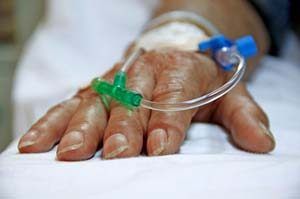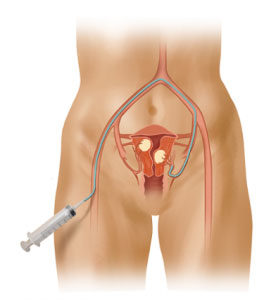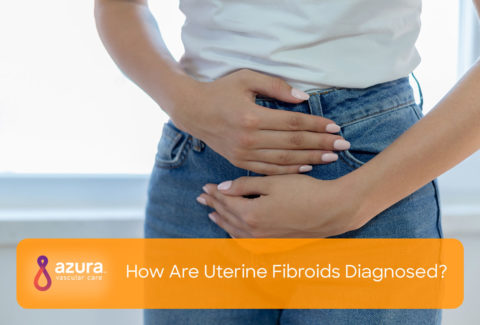
Are you considering uterine fibroid embolization (UFE) for the treatment of your uterine fibroids? UFE is a minimally invasive alternative treatment option to hysterectomy and myomectomy, two common surgeries for uterine fibroids. UFE is one of many outpatient procedures performed by interventional radiologists every day. While there may be different approaches to performing UFE, in general, there is a standard technique for the procedure.
What is Uterine Fibroid Embolization?
Before you learn what specifically happens during the UFE procedure, you need to understand what it is designed to do and how it can be helpful. Uterine fibroids are non-cancerous tumors of the uterus that can cause bleeding and pain. There are many treatment options for fibroids — some procedures treat just the symptoms while others, such as UFE, directly target the fibroids. UFE involves placing small beads to block the arteries that supply blood to the fibroids, thereby causing the fibroids to shrink and providing symptom relief. There are two main uterine arteries that can supply blood to the fibroids and both are evaluated during the same procedure.
RELATED: The Benefits of Uterine Fibroid Embolization
The 5 Phases to the UFE Procedure Process
Phase 1 – Before the UFE Procedure
The night before your procedure, you will need to stop eating food at a certain point. The timing of this depends upon when your procedure is scheduled for the next day and will be explained clearly to you in your preoperative instructions. Later, you will need to stop drinking water as well. Don’t worry, you will not become dehydrated from this safety precaution. If you take any medications, you will be given instructions on whether or not you should stop prior to your procedure.
RELATED: Where are Uterine Fibroid Embolization Procedures Performed?
Phase 2 – Pre-Procedure Preparation
 After you arrive and check in for your procedure, an IV will be placed in your hand or forearm, which will allow you to receive medications for sedation and to treat pain. You will also have a catheter placed in your bladder to keep it empty during the procedure. This measure will keep your bladder out of the way during the procedure and prevent it from being injured. You will be taken from the pre-procedure preparation area to the procedure room.
After you arrive and check in for your procedure, an IV will be placed in your hand or forearm, which will allow you to receive medications for sedation and to treat pain. You will also have a catheter placed in your bladder to keep it empty during the procedure. This measure will keep your bladder out of the way during the procedure and prevent it from being injured. You will be taken from the pre-procedure preparation area to the procedure room.
Phase 3 – Inside the Procedure Room
Getting the Catheter in the Femoral Artery 
To prevent infection, the skin of your groin will be cleansed and then a drape will be placed over the surrounding area to keep it sterile, or as clean as possible. A numbing medication will be injected into the skin in the right groin directly over the femoral artery. A small nick in the skin will be made to make an opening for the catheter to go through your skin. Then, the catheter will be inserted into the femoral artery. While this procedure should not be painful, you may feel pressure.
Getting the Catheter in the Radial Artery
An alternative approach involves using the radial artery (in your wrist), rather than the femoral artery. To prevent infection, the skin of your right or left wrist will be cleansed and then a drape will be placed over the surrounding area to keep it sterile, or as clean as possible. A numbing medication will be injected into the skin over the radial artery. A small nick in the skin will be made to make an opening for the catheter to go through your skin. Then, the catheter will be inserted into the radial artery. While this procedure should not be painful, you may feel pressure.
Getting to the Blood Supply of the Fibroids
The catheter that’s inside the femoral or radial artery is a long thin tube through which dye and beads for embolization can be passed. It will be advanced through the selected artery (femoral or radial) to the first uterine artery. Contrast dye will be injected through the catheter to help see which blood vessels are supplying the fibroids.
Embolization
After the correct blood vessels have been identified, tiny particles, or beads, are injected through the catheter and block the blood flow to the fibroids. Another injection of contrast will help make sure that the beads were placed successfully. This is repeated for the second uterine artery.
Phase 4 – After the Procedure
Once the procedure is completed, the catheter will be removed and a bandage will be placed over the nick in your groin or wrist. You will be taken to the recovery room where you will need to lie flat for a while, to prevent any bleeding from the catheter site. You will receive additional medication to control any pain or nausea that you experience. After you are cleared to sit up and move around, the catheter in your bladder will be removed. If the catheter was in your radial artery, you may have a quicker immediate recovery following surgery.
Phase 5 – Discharge
If everything is going well, you will be discharged. At this point you will have a small bandage over the small nick in your groin or wrist. You may be given a prescription for pain medication to use at home while you are recovering. You will also be given activity and post-procedure care instructions.
RELATED: What to Expect While Recovering From Uterine Fibroid Embolization
By the end of the day of your procedure, if all goes as intended, you will be recovering in your own home. When compared to surgery, there is a notable difference in the approach taken when the UFE procedure is performed for the treatment of fibroids. There is minimal bleeding, less risk of complications and infection, and no major surgery needed. If you are interested in UFE as a treatment for your fibroids, be sure to make an appointment with an interventional radiologist to discuss your medical history, symptoms, and goals.
Sources:
http://www.mayoclinic.org/tests-procedures/uterine-artery-embolization/basics/how-you-prepare/prc-20020425
http://www.sirweb.org/patients/uterine-fibroids/


